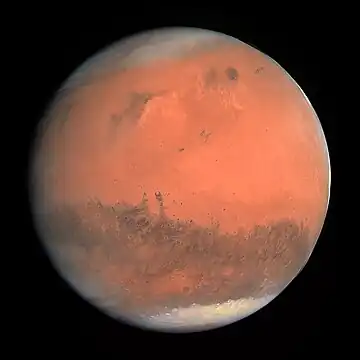
Mars is the fourth planet from the Sun. The surface of Mars is orange-red because it is covered in iron(III) oxide dust, giving it the nickname "the Red Planet". Mars hosts many enormous extinct volcanos (such as Olympus Mons, 21.9 km or 13.6 mi tall) and one of the largest canyons in the Solar System (Valles Marineris, 4,000 km or 2,500 mi long). For comparison, Mars's diameter is 6,779 km (4,212 mi). It is the second smallest of the Solar System's planets.
When viewed closely, the relatively flat plains in northern parts of Mars strongly contrast with the cratered terrain in southern highlands – this terrain observation is known as the Martian dichotomy. Geologically, the planet is fairly active with marsquakes trembling underneath the ground, dust devils sweeping across the landscape, and cirrus clouds that are probably made from solid carbon dioxide. Other places where carbon dioxide is present in Mars are its polar ice caps and thin atmosphere. (Full article...)